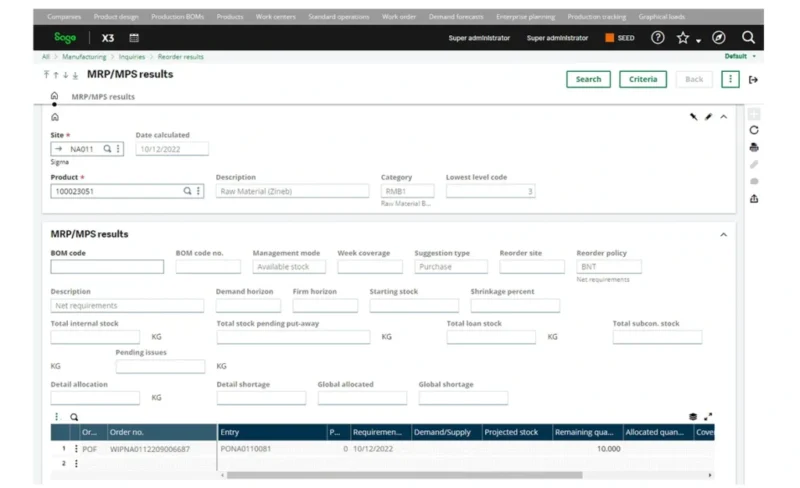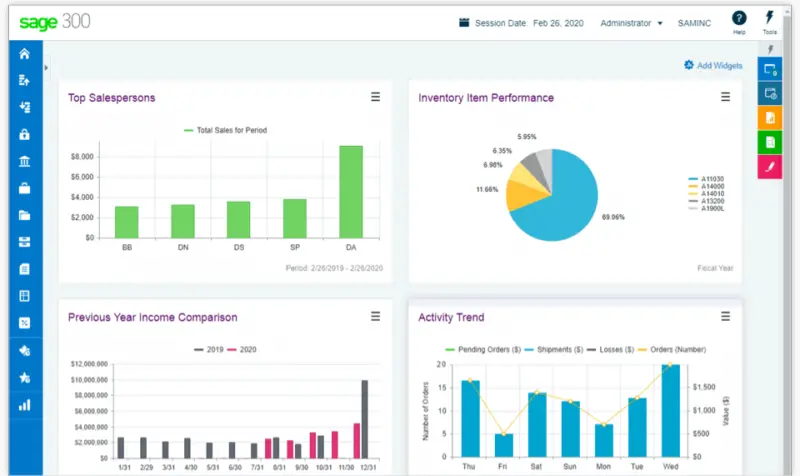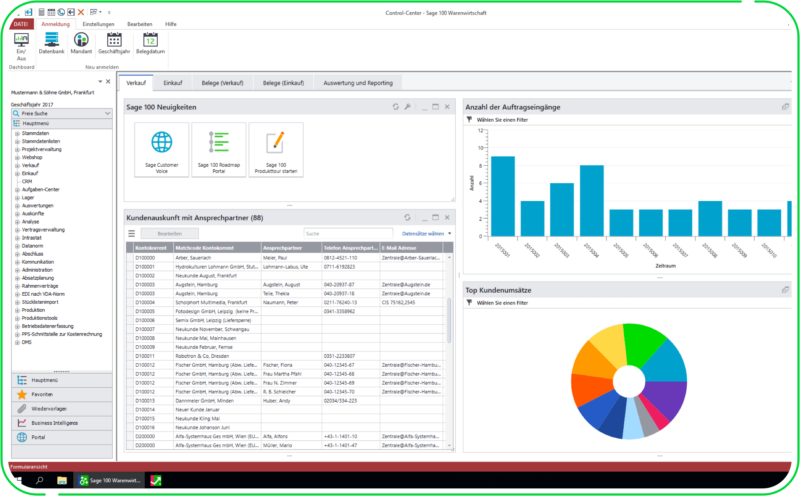In today’s dynamic business environment, outperforming competitors demands effective resource management, streamlined processes, and instant insights. Discover the significance of Sage ERP Software for businesses and its role in driving success.
TOC
- 1. What is Sage ERP Software?
- 2. Importance of Sage ERP Software in Business Operations
- 3. Features and Benefits of Sage ERP Software
- 4. Choosing the Right Sage ERP Software for Your Business
- 5. Implementing Sage ERP Software Successfully
- 6. Case Studies: Real-World Examples of Sage ERP Software Implementation
- 7. Conclusion and Future Trends in Sage ERP Software

What is Sage ERP Software?
Sage ERP Software is a comprehensive enterprise resource planning solution designed to integrate various business functions and streamline operations. It serves as a centralized hub, enabling businesses to manage essential processes such as finance, inventory, supply chain, and reporting in a seamless manner. With Sage ERP Software, businesses can drive efficiency, enhance productivity, and make informed decisions based on accurate data.
Importance of Sage ERP Software in Business Operations
In the competitive business landscape, efficiency is the key to success. Sage ERP Software plays a vital role in enhancing operational efficiency by automating manual tasks, eliminating redundant processes, and optimizing resource allocation. By providing a holistic view of the entire business, Sage ERP Software empowers organizations to make data-driven decisions, identify trends, and adapt swiftly to market changes.
But the benefits of Sage ERP Software go beyond operational efficiency. It also enables enhanced financial management, ensuring accurate and timely financial reporting, reducing errors, and improving compliance. With real-time insights and analytics, businesses can gain a deeper understanding of their financial health, identify areas for improvement, and allocate resources strategically.
Furthermore, Sage ERP Software offers robust inventory and supply chain management capabilities. It helps businesses optimize inventory levels, streamline procurement processes, and improve order fulfillment. By maintaining accurate inventory records and minimizing stockouts, businesses can enhance customer satisfaction and boost profitability.
In conclusion, Sage ERP Software is a powerful tool that helps businesses streamline operations, drive efficiency, and make informed decisions. From finance to inventory management, it empowers organizations to adapt to the ever-changing business landscape and achieve sustainable growth. Stay tuned as we delve deeper into the features, benefits, and successful implementation of Sage ERP Software. [erp.ebest.vn]
Features and Benefits of Sage ERP Software

Sage ERP Software offers a wide range of features and benefits that enable businesses to optimize their operations and achieve sustainable growth. Let’s explore some of the key advantages this robust solution brings to the table.
Streamlined Business Processes
Sage ERP Software enhances operational efficiency by automating repetitive tasks and eliminating manual errors. It facilitates seamless data integration across various departments, fostering collaboration within the organization. From order management to production planning, the software optimizes workflows to minimize bottlenecks and boost productivity.
Enhanced Financial Management
Financial management is a pivotal aspect of any business, and Sage ERP Software stands out in this domain. It offers a comprehensive suite of tools for managing accounts payable and receivable, general ledger, budgeting, and cash flow. With access to real-time financial insights and customizable reports, businesses can achieve greater transparency in financial performance, make precise forecasts, and ensure adherence to regulatory standards.
Improved Inventory and Supply Chain Management
Sage ERP Software provides robust inventory and supply chain management functionalities. It empowers businesses to monitor and control inventory levels, automate purchase requisitions, and streamline warehouse operations. By mitigating stockouts and optimizing replenishment processes, businesses can elevate customer satisfaction, reduce carrying costs, and enhance overall supply chain effectiveness.
Comprehensive Reporting and Analytics
Effective decision-making relies on precise and timely information. Sage ERP Software offers extensive reporting and analytics tools, empowering businesses to acquire valuable insights into their operations. Through customizable dashboards and real-time data, users can track key performance indicators, recognize trends, and execute data-informed decisions that foster business growth.
Scalability and Customization Options
As businesses progress and expand, they require software solutions that can expand alongside their needs. Sage ERP Software provides scalability, enabling businesses to incorporate new modules, users, and functionalities as their demands evolve. Additionally, the software offers customization options, allowing businesses to personalize the system to fit their distinctive processes and industry-specific requirements.
Integration with Third-Party Applications
To further augment its capabilities, Sage ERP Software seamlessly integrates with diverse third-party applications. Whether it involves CRM software, e-commerce platforms, or business intelligence tools, the integration features of Sage ERP Software empower businesses to utilize their current tech stack and optimize the value of their investments.
In the subsequent section, we will delve into selecting the appropriate Sage ERP Software for your business, ensuring a smooth implementation that aligns with your specific needs and requirements. Stay tuned for valuable insights!
Choosing the Right Sage ERP Software for Your Business

When selecting the suitable Sage ERP Software for your business, it is imperative to carefully consider various aspects to ensure a seamless integration and optimal performance. Let us explore the fundamental steps to guide you in making an informed decision:
Understanding Your Business Needs and Requirements
Prior to exploring the array of available options, take a moment to assess your business needs and requirements. Identify the challenges, barriers, and areas in need of improvement within your organization. Do you require advanced financial management tools? Are you looking to streamline your supply chain operations? Understanding your specific needs will help in pinpointing the essential features and functionalities necessary in a Sage ERP Software solution.
Evaluating Different Sage ERP Software Solutions
With numerous Sage ERP Software solutions in the market, conducting a comprehensive evaluation is crucial. Research and compare various offerings, considering factors such as scalability, user-friendliness, integration capabilities, and industry-specific features. Review user feedback, case studies, and testimonials to evaluate the software’s reliability and performance. Additionally, take into account the vendor’s reputation, experience, and customer support services.
Addressing Financial Constraints
While feature-rich solutions may be appealing, it is vital to take your budget constraints into consideration. Determine the allocated budget for implementing Sage ERP Software and compare it against the features and benefits offered by each solution. Remember, investing in the appropriate software that aligns with your business objectives and financial strategy will result in a significant long-term return on investment.
Consulting Professionals
If you require assistance in the selection process or aim for a smooth implementation, do not hesitate to seek expert advice or consulting services. ERP consultants can provide valuable insights, help define your requirements, and assist in choosing the most suitable Sage ERP Software for your business. Their expertise and knowledge can save you time, effort, and costly mistakes.
By following these steps, understanding your business requirements, assessing different solutions, adhering to your budget, and leveraging expert advice, you can confidently select the right Sage ERP Software that aligns with your business goals. Stay tuned for further insights on the successful implementation of Sage ERP Software in the upcoming section.
Implementing Sage ERP Software Successfully

Efficient implementation is crucial to maximize the benefits of Sage ERP Software. Let’s explore the key steps involved in successfully implementing this powerful solution.
A. Planning and Preparation
Implementing Sage ERP Software begins with careful planning and preparation. This phase involves assessing your business needs, defining project objectives, and establishing a clear roadmap. Start by identifying key stakeholders and assembling a dedicated implementation team. Collaborate with them to set realistic timelines, allocate resources, and define measurable goals. Conduct a thorough analysis of your existing processes, identify pain points, and document the desired outcomes you hope to achieve with Sage ERP Software.
B. Data Migration and System Configuration
The next step in implementing Sage ERP Software is migrating your data and configuring the system to align with your business requirements. Ensure that your data is clean, accurate, and compatible with the new system. Develop a data migration plan that includes data mapping, extraction, transformation, and validation. Work closely with your implementation team and Sage ERP consultants to configure the system modules, workflows, and user permissions. Tailor the software to meet your specific business needs, such as customizing reports, templates, and dashboards.
C. User Training and Adoption Strategies
To ensure a successful implementation, it is crucial to invest in comprehensive user training and adoption strategies. Conduct training sessions that cater to different user roles and provide hands-on experience with Sage ERP Software. Empower your employees with the knowledge and skills necessary to navigate the system, enter data accurately, and leverage its features effectively. Encourage user adoption by highlighting the benefits and demonstrating how the software streamlines their daily tasks, improves productivity, and enhances their overall work experience.
D. Ongoing Support and Maintenance
To ensure sustained performance, incorporating Sage ERP Software is a continuous endeavor, not a one-off task. Create a robust support system to address user queries, troubleshoot issues, and offer ongoing assistance. Monitor system performance regularly, update software, and stay abreast of the latest features. Collaborate closely with your implementation team and Sage ERP support for seamless integration with other software solutions and to adapt to changing business requirements. Prioritizing continuous support and maintenance will enhance the longevity and efficiency of your Sage ERP Software implementation.
Stay tuned for insights into successful real-world implementations of Sage ERP Software and the tangible benefits they bring to businesses. petfoodsreviews.com
Case Studies: Real-World Examples of Sage ERP Software Implementation

For those considering an ERP solution, real-world success stories offer valuable insights into the benefits and impact of Sage ERP Software. Let’s delve into case studies showcasing how businesses have utilized Sage ERP Software to revolutionize their operations and attain extraordinary outcomes.
Metro Motors (Manufacturing)
This Michigan-based auto parts manufacturer is facing challenges with production bottlenecks and outdated inventory management systems. By implementing Sage Business Cloud Manufacturing, they can streamline production processes, enhance forecasting accuracy, and obtain valuable real-time insights into their inventory levels. This comprehensive solution offers a range of tools and features designed to specifically address the needs of manufacturers, ultimately assisting them in achieving operational efficiency and boosting overall productivity.

Sunshine Distributors (Distribution)
This Florida-based distributor of pool supplies, located in the bustling city of Miami, faces ongoing challenges with slow order fulfillment and inaccurate warehouse inventory management practices. The implementation of Sage ERP Cloud X3, a cutting-edge cloud-based solution, could revolutionize their operations. By automating order picking processes, optimizing warehouse layouts to maximize space utilization, and offering real-time visibility into stock levels through advanced tracking technologies, the distributor can achieve faster order fulfillment times, streamline inventory management, and ultimately enhance overall operational efficiency.
Green Earth Foundation (Non-Profit)
This national environmental organization needs a better way to manage donations, track project funding, and generate reports. Sage Intacct Accounting could streamline their financial processes, improve grant management, and facilitate easier reporting for donors, increasing transparency and accountability.
These case studies illustrate how Sage ERP Software has helped companies overcome diverse operational challenges, drive efficiency, and achieve tangible results. By leveraging the power of Sage ERP Software, businesses can transform their operations and position themselves for long-term success. Stay tuned as we delve deeper into the implementation process and best practices for Sage ERP Software.
Conclusion and Future Trends in Sage ERP Software

Upon concluding our examination of Sage ERP Software, it is apparent that this robust solution has emerged as an indispensable asset for businesses spanning diverse industries. By streamlining operations, fortifying financial management, and optimizing inventory processes, Sage ERP Software equips organizations to attain operational efficiency and foster growth.
In the swiftly evolving business environment of today, maintaining a forward-thinking approach is paramount. Sage ERP Software not only caters to current business requirements but also positions them for future challenges. With the advent of new trends and innovations, Sage ERP Software continually progresses, offering enhanced capabilities and prospects for organizational advancement.
Looking ahead, several promising trends are anticipated in Sage ERP Software. One notable trend involves the integration of artificial intelligence (AI) and machine learning (ML) functionalities. By incorporating AI and ML, predictive analytics, task automation, and insightful data analysis capabilities are enabled, facilitating proactive decision-making for businesses. This integration is poised to elevate process efficiency and accuracy within Sage ERP Software, consequently bolstering productivity and profitability.
Another significant trend is the focus on cloud-based solutions. Leveraging cloud technology provides businesses of all sizes with scalability, flexibility, and cost-efficiency. Sage ERP Software harnesses cloud capabilities to deliver real-time data accessibility, promote collaboration, and ensure seamless updates and enhancements.
Furthermore, the increasing significance of mobility in the corporate sphere cannot be overstated. With the surge in remote work practices and the demand for on-the-go information access, Sage ERP Software is adapting to offer mobile-responsive interfaces and applications. This adaptation empowers employees to retrieve critical data and execute essential tasks from any location, thereby fostering productivity and agility.
In summation, Sage ERP Software stands out as a transformative tool for businesses, furnishing a holistic solution for operational management and optimization. Armed with a diverse range of features, benefits, and future-oriented trends, Sage ERP Software empowers organizations to uphold their competitive edge, make well-informed choices, and steer towards success.
